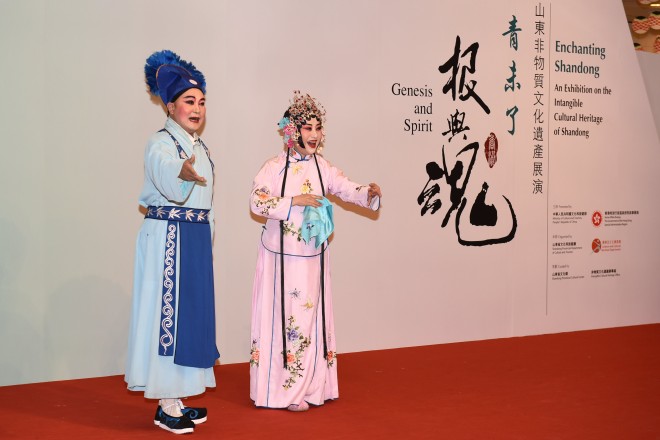
Discover the genesis and spirit of Chinese culture, immerse in cultural charms of Shandong
[Sponsored Article]
Shandong Province may be historically known as the birthplace of Confucius and Mencius. It is a region with industrious and ingenuous people, who have built upon national traditions and ancient arts, and added local elements to form uniquely Shandong variations. No wonder this province is known as one of the cradles of Chinese civilisation.
An exhibition and event series, Genesis and Spirit – Enchanting Shandong‧An Exhibition on the Intangible Cultural Heritage (ICH) of Shandong”, now welcome visitors to experience for themselves the intangible cultural heritage of Shandong. A total of 37 intangible cultural heritage items are showcased in this exhibition through photographs, video screenings and traditional handicraft.
Fostering closer ties between the people of Shandong and Hong Kong, the Genesis and Spirit programmes are designed for the Hong Kong public to discover how the history and traditions of Shandong live on today.
The exhibition is the largest of its kind featuring intangible cultural heritage from China. To facilitate understanding of the exhibited art and culture, on a daily basis there are several representatives from Shandong Province – contemporary practitioners of the intangible cultural heritage – who would be present to demonstrate the art. Visitors can therefore see and experience the cultural heritage come to life.
Zhao Xintian, the deputy curator of the Shandong Provincial Cultural Centre, said that
Some of the intangible cultural heritage have become livelihoods for entire villages. Others have come up with new ways to apply the ancient arts onto modern contexts.
“At the end of the day, intangible cultural heritage is about people,” she said. “We must have the people here to tell the story, and to carry the torch of the heritage to the generations to come.”
At the exhibition, miniature carving has been demonstrated on mobile phone cases, instead of carving on jade and precious stones.
There is a type of folk toys known as Liu’s cloth dolls on display, an art dating back to Qing Dynasty, that are now viable online and offline businesses selling handcrafted dolls across China.
The programme runs until 23 June at the exhibition gallery of the Hong Kong Central Library. It is jointly presented by the Ministry of Culture and Tourism and the Home Affairs Bureau, jointly organised by the Shandong Provincial Department of Culture and Tourism and the Leisure and Cultural Services Department, and curated by the Shandong Provincial Cultural Center and the Intangible Cultural Heritage Office.
Shandong has an impressive list of intangible cultural heritage. The province has 8 items inscribed onto the UNESCO Representative List of Intangible Cultural Heritage. In China, the National List of Intangible Cultural Heritage includes 173 items from Shandong at the national level, 751 at the provincial level, 3,490 at the city level, and 10,544 at the county level.
Brian Lam, Curator of the Intangible Cultural Heritage Office, said that the exhibition is also an opportunity for closer ties between Hong Kong and Shandong.
As many of the intangible cultural heritage items from Shandong are linked to Chinese arts that are widely practised across the country, many groups and individuals in Hong Kong practising Chinese music, opera and other crafts can use this exhibition as an opportunity for cultural exchange.
Lam said that groups practising guqin, the ancient string instrument of the zither family, and local opera groups could meet directly with the Shandong representatives during the exhibition and associated events.
The organisers have prepared a series of events showcasing Shandong traditional arts, including handicraft, vernacular music, regional theatre and witty narrative singing performances. Representatives from Shandong will perform and demonstrate various arts and activities that are intangible cultural heritage. Demonstrations -- 30-minute sessons over the weekends of June 22-23 -- include Liuzi opera, Shandong Kuaishu and Shandong folk songs.
Eight experts of Shandong culture have also been invited to give talks and demonstrations on various aspects of intangible cultural heritage, from shadow puppetry to regional opera.


Highlight exhibits include the Weifang kite “Phoenix”; “Harvesting Fruit”, which displays the production techniques of Dongming foodstuff art; “Jade Seals featuring the Twelve Beauties of Jinling”, which is a miniature carving from Jinan; “Exquisite brush set with cloisonné tube and wolf’s hairs”, showcasing the techniques of the making the Qi writing brush of Guangrao; “Babies’ bibs with tiger design”, showing Feixian hand embroidery; “Jimo lace tablecloth – Gorgeous Blooms”, displaying the traditional handicraft style of Jimo lace; and “Boy with Fish”, a Nie clay figurine.

